
An all-terrain vehicle (ATV), also known as a light utility vehicle (LUV), a quad bike or quad, as defined by the American National Standards Institute (ANSI), is a vehicle that travels on low-pressure tires, has a seat that is straddled by the operator, and has handlebars. As the name implies, it is designed to handle a wider variety of terrain than most other vehicles. It is street-legal in some countries, but not in most states, territories and provinces of Australia, the United States, and Canada.

The Honda CB750 is an air-cooled, transverse, in-line-four-cylinder-engine motorcycle made by Honda over several generations for year models 1969–2003, 2007, and 2023-present with an upright, or standard, riding posture. It is often called the original Universal Japanese Motorcycle (UJM).
The Honda XR series is a range of four-stroke off-road motorcycles that were designed in Japan but assembled all over the world.
A semi-automatic transmission is a multiple-speed transmission where part of its operation is automated, but the driver's input is still required to launch the vehicle from a standstill and to manually change gears. Semi-automatic transmissions were almost exclusively used in motorcycles and are based on conventional manual transmissions or sequential manual transmissions, but use an automatic clutch system. But some semi-automatic transmissions have also been based on standard hydraulic automatic transmissions with torque converters and planetary gearsets.
The Honda CR series was a line of two-stroke off-road motorcycles made by Honda from 1973 to 2007. They are racing motorcycles with countless trophies in the 125, 250 and 500 motocross classes. Marty Smith, Jeremy McGrath, Ricky Carmichael and many other motocross legends dominated racing circuits on Honda CR's. CR's continue competing today and are prized by racing enthusiasts and collectors alike.

The L-series is a compact inline-four engine created by Honda, introduced in 2001 with the Honda Fit. It has 1.2 L (1,198 cc), 1.3 L (1,318 cc) and 1.5 litres (1,497 cc) displacement variants, which utilize the names L12A, L13A and L15A. Depending on the region, these engines are sold throughout the world in the 5-door Honda Brio Fit/Jazz hatchback Honda Civic and the 4-door Fit Aria/City sedan. They can also be found in the Japanese-only Airwave wagon and Mobilio MPV.
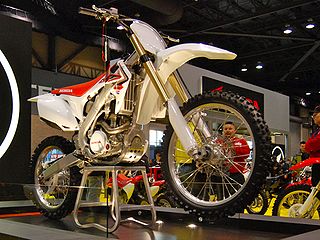
The Honda CRF series is a line of four-stroke motocross, trail, and dual sport motorcycles manufactured and marketed by Honda.
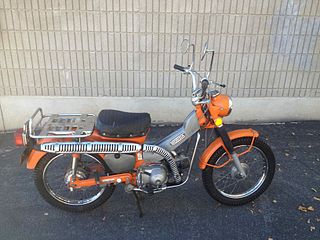
The Honda CT90 was a small step-through motorcycle manufactured by Honda from 1966 to 1979. It was offered in two models: Trail or X with the main variations being gear ratios and tyre style.

The VT250 or Spada MC20 is a Honda motorcycle built between late 1988 and the end of 1989.
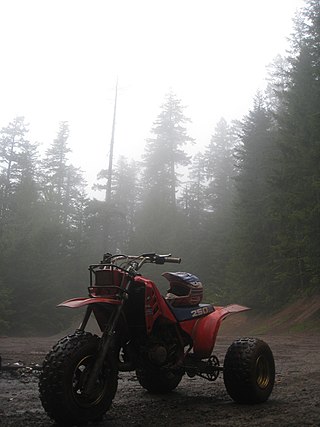
The ATC250R is a high-performance, three-wheeled ATV produced by Honda from 1981 to 1987. Cited as the first high performance ATC introduced, production began with an air-cooled, 248 cc single-cylinder two-stroke engine, but would see a liquid-cooled, 246 cc engine by 1985. All model years were fully suspended and adjustable, using air-assisted front forks and a single, remote reservoir gas-charged rear shock. 1981–1982 models offered 6.7 inches of front suspension travel and 4.3 inches in the rear, 1983–1984 offered 8.7 inches in front and 8.1 inches rear, while post-1985 models allowed 9.8 inches of travel. All model years also used a gear-driven counter-balancer to reduce engine vibration. Dual disc brakes were used on all model years, with the exception of the 1981, which used a front disc and a rear drum.

The Honda PC50 is a moped produced by the Honda Motor Company in Japan from May 1969 until at least 1983. The PC50, though much smaller and lighter, had some similar features to Honda's popular C50 /70 /90 Super Cub line, with a step-through pressed-steel frame, a fuel tank under the saddle, a chain cover, and optionally equipped with leg shields,
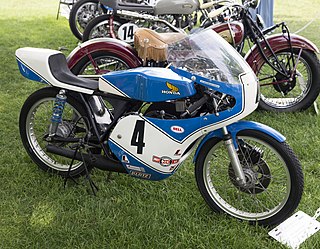
The Honda MT125R was a production Grand Prix motorcycle racing roadracer designed for closed-course competition roadracing. It was produced by Honda Racing Service Center (RSC) and made available to the general public. It was also marketed for the U.S. market in the years 1977–1978 through the American Honda Motorcycle dealer network and in Canada through Canadian Honda Motors Ltd.,
The Suzuki LT250R was a sport/racing ATV manufactured between 1985 and 1992. It combined a lightweight fully suspended frame with a 249cc liquid cooled two stroke engine.
The Honda TMX or Tricycle Model Xtreme series is a line of motorcycles manufactured by Honda Motors Philippines since 1976. Produced for the Philippine market, it was designed for utility and tricycle use.
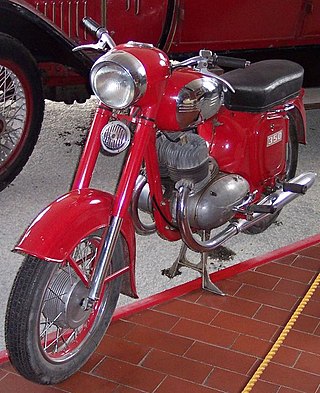
The Jawa 350 is a motorcycle, produced by Jawa Moto in Czechoslovakia since the 1930s until 1992 and in the Czech Republic until present. In the 1950s, with its two-stroke, air-cooled 343 cc engine it could reach speeds of 132 kilometres per hour (82 mph) and was exported into over 120 countries of the world.

The BMW M2 is a version of the BMW 2 Series automobile developed by BMW's motorsport division, BMW M GmbH. As the 2 Series replaced the 1 Series coupé and convertible models, the first-generation M2 was marketed as the most basic M Car in the range. The first-generation M2 used the F8x chassis from the M3/M4, code name F87 and featured a more powerful and responsive, turbocharged and slightly modified BMW N55 series engine, while its successors, the M2 Competition and M2 CS, featured a high-performance twin-turbocharged engine developed by BMW M GmbH ; improved handling, suspension, and braking systems; aerodynamic body enhancements; interior/exterior accents with the tri-colour "M" (Motorsport) badging and increased weight. The M2 is unofficially considered as an indirect successor to the BMW 1 Series M Coupé.
The Honda US90 was a three-wheeled Recreational vehicle designed by Osamu Takeuchi. Development began in 1967, in response to requests from American dealers for products to sell in the motorcycle off-season. Takeuchi considered many variations before settling on a three-wheeled design with low-pressure ballon tires, driven by an enlarged Honda ST70 engine, through a 4 Speed Dual-Range Semi automatic clutched transmission.
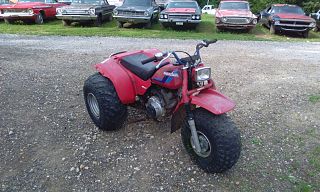
The Honda ATC200 is an all-terrain vehicle that was introduced in 1981 as Honda's top model in the ATC line-up, remaining, in various forms, until Honda voluntarily ceased production in 1987. In the six years of production, six variations were made, often sold concurrently. Collectively, Honda produced over 530,000 ATC200 vehicles, becoming the most prolific sellers in the ATC market, and one of the most recognizable ATCs available.
The Honda ATC125M was a three-wheeled All Terrain Cycle released in 1984, and received a major revision in 1986. The model was sold through 1987, when Honda voluntarily discontinued sales of ATC's. The first iteration can trace its development back to Honda's first ATC, the Honda US90, released in 1970, while the second iteration borrowed heavily from the ATC200 line.












